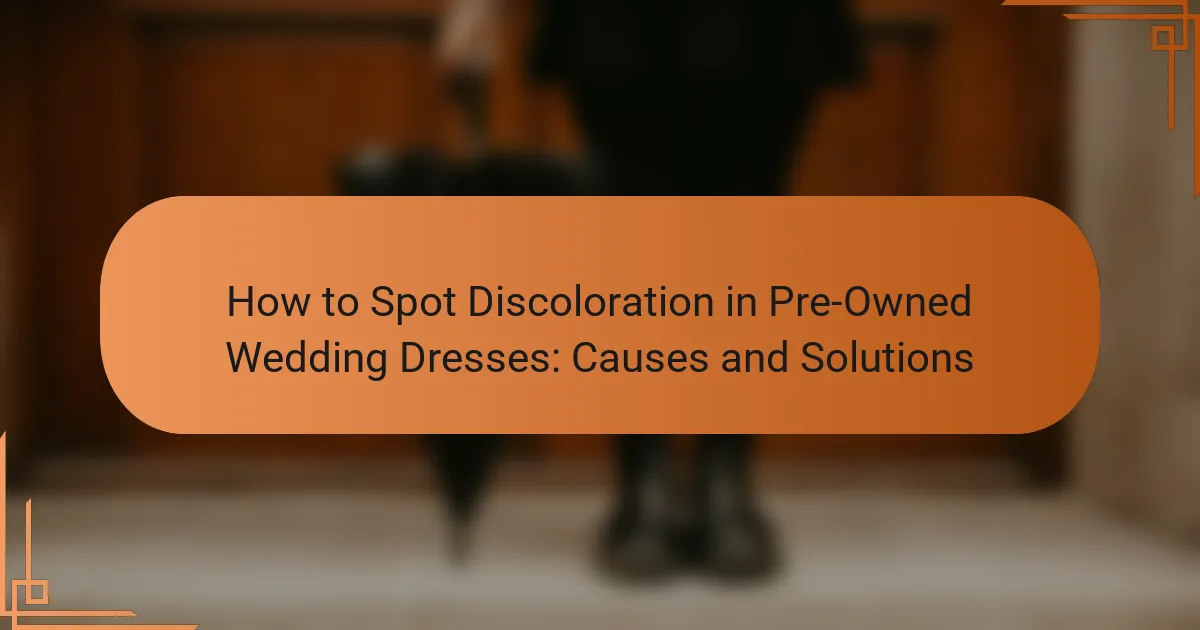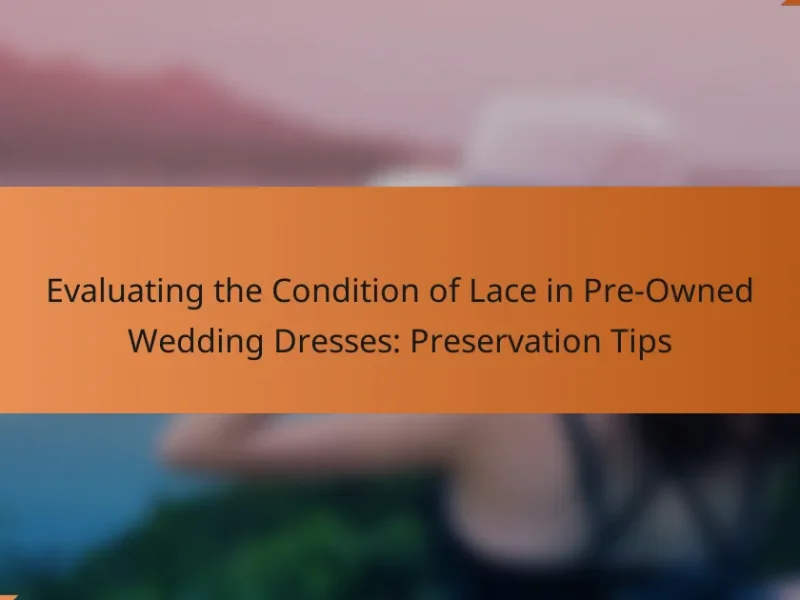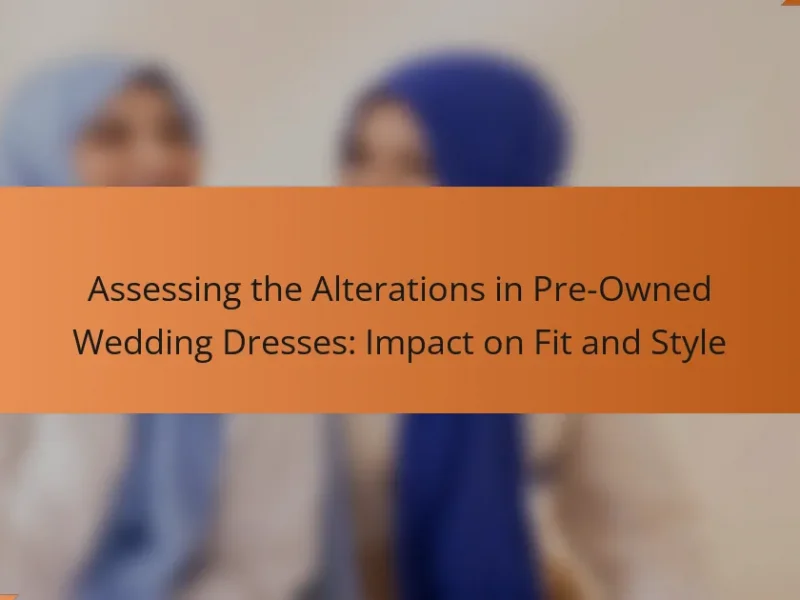Discoloration in pre-owned wedding dresses refers to the change in color or appearance of the fabric, which can be caused by factors such as age, light exposure, and improper storage. Common discoloration types include yellowing, browning, and fading, often resulting from fiber breakdown or stain accumulation. Identifying signs of discoloration, including grayish patches that may indicate mildew, is essential for restoration or resale. Solutions for treating discoloration encompass professional cleaning, targeted stain removal treatments, and fabric whitening agents, all of which can effectively restore the dress’s original appearance when properly applied. Regular maintenance and appropriate storage are key to preventing discoloration.
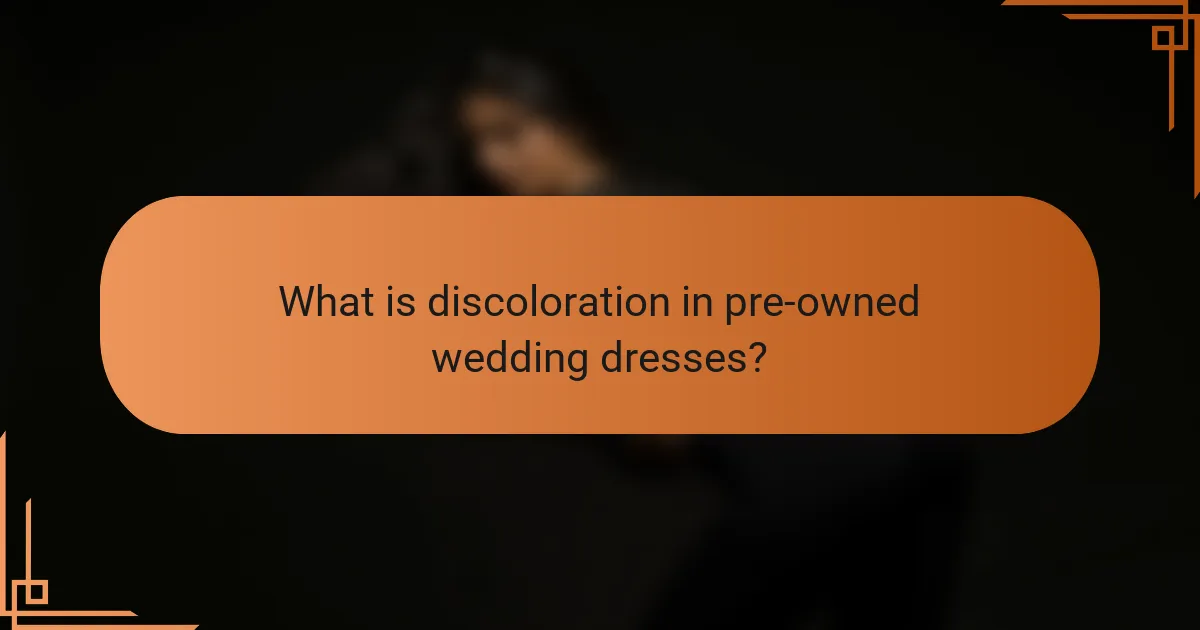
What is discoloration in pre-owned wedding dresses?
Discoloration in pre-owned wedding dresses refers to the change in color or appearance of the fabric. It can occur due to various factors such as age, exposure to light, or improper storage. Common types of discoloration include yellowing, browning, or fading. These changes often result from the breakdown of fibers or the accumulation of stains. For example, silk and satin fabrics are particularly prone to yellowing over time. Discoloration can affect the overall aesthetic of the dress, making it less appealing. Identifying and addressing discoloration is crucial for restoration or resale purposes.
How does discoloration occur in wedding dresses?
Discoloration in wedding dresses occurs due to various factors. Exposure to sunlight can cause fabrics to fade over time. Accumulation of body oils and sweat can lead to yellowing, especially in lighter fabrics. Certain cleaning agents can also react negatively with the fabric, resulting in discoloration. Additionally, improper storage conditions, such as high humidity, can contribute to fabric degradation. Wedding dresses made from synthetic materials may discolor more quickly than those made from natural fibers. Regular maintenance and proper storage can help prevent these issues.
What are the common causes of discoloration in fabrics?
Common causes of discoloration in fabrics include exposure to sunlight, moisture, and improper cleaning methods. Sunlight can fade colors over time, leading to discoloration. Moisture from spills or humidity can cause stains or mildew. Improper cleaning, such as using harsh detergents or incorrect washing temperatures, can also result in discoloration. Additionally, chemical reactions with certain fabrics or dyes can lead to unwanted color changes. These factors contribute to the overall deterioration of fabric appearance.
How do environmental factors contribute to discoloration?
Environmental factors contribute to discoloration by exposing materials to elements that cause chemical reactions. Sunlight can lead to fading by breaking down pigments in fabrics. Humidity promotes mildew, which can stain and discolor materials. Pollution can deposit particles that alter the color of textiles. Temperature fluctuations can cause fabric fibers to expand and contract, leading to wear and discoloration. These factors can interact, compounding their effects and leading to significant changes in appearance over time.
Why is it important to spot discoloration early?
Spotting discoloration early is crucial for preserving the quality of pre-owned wedding dresses. Early detection allows for timely treatment, which can prevent further damage. Discoloration can indicate underlying issues like fabric degradation or mold growth. Addressing these problems promptly can save the dress from irreversible harm. According to textile conservation experts, untreated discoloration can lead to permanent staining. This can significantly reduce the dress’s aesthetic and monetary value. Therefore, early intervention can maintain both the dress’s appearance and its resale potential.
What impact does discoloration have on the overall appearance of a wedding dress?
Discoloration significantly affects the overall appearance of a wedding dress. It alters the dress’s intended color, making it look aged or unkempt. This can detract from the bride’s desired aesthetic on her special day. For instance, yellowing or browning can occur due to exposure to light, moisture, or improper storage. Such changes can create an impression of neglect or poor maintenance. A wedding dress should ideally maintain its original hue for a pristine look. Discoloration can also impact the fabric’s texture, making it appear less luxurious. Overall, discoloration diminishes the visual appeal and can affect the bride’s confidence.
How can discoloration affect the resale value of a wedding dress?
Discoloration can significantly lower the resale value of a wedding dress. Buyers often seek pristine, white or ivory dresses. Any yellowing or staining indicates wear and can deter potential buyers. Research shows that wedding dresses with discoloration can lose up to 50% of their original value. This depreciation occurs because discoloration suggests poor maintenance or damage. Restoration can be costly and may not fully restore the dress’s original appearance. Therefore, the presence of discoloration directly impacts marketability and price.
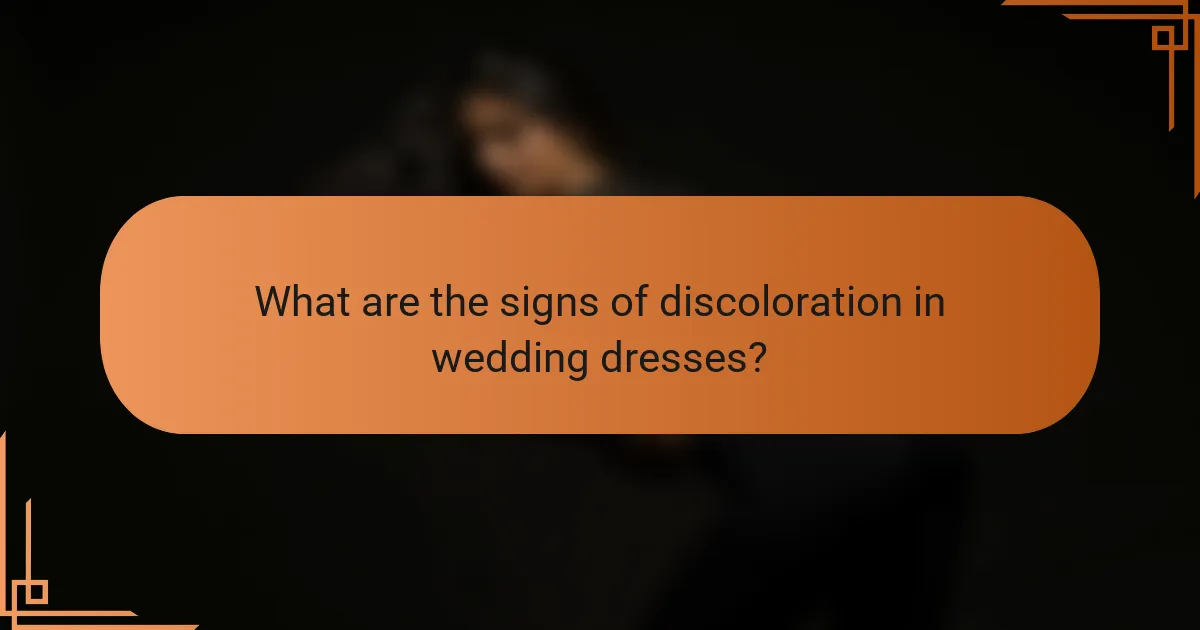
What are the signs of discoloration in wedding dresses?
Signs of discoloration in wedding dresses include yellowing, browning, and grayish patches. Yellowing often occurs due to age or exposure to light. Browning can result from stains that have set over time. Grayish patches may indicate mildew or mold growth. Discoloration can affect both the fabric and embellishments. Inspecting the dress under natural light can reveal these signs more clearly. Regular maintenance and proper storage can help prevent discoloration.
How can you identify yellowing or fading in fabrics?
To identify yellowing or fading in fabrics, examine the color and brightness of the material. Yellowing typically appears as a discoloration that alters the original hue. Fading indicates a loss of vibrancy and can make colors look dull. Inspect the fabric under natural light for better visibility. Compare the affected areas to untouched sections to assess the extent of discoloration. Fabrics made from natural fibers, like silk or cotton, are more prone to yellowing due to exposure to moisture and light. In contrast, synthetic fabrics may fade due to prolonged sunlight exposure. Regular cleaning and proper storage can prevent such changes.
What specific areas of a wedding dress are prone to discoloration?
The specific areas of a wedding dress that are prone to discoloration include the bodice, hemline, and underarm areas. The bodice often experiences discoloration due to body oils and sweat. The hemline is susceptible to dirt and dust accumulation, especially if the dress is worn outdoors. Underarm areas may discolor from perspiration and deodorant residue. These areas are commonly affected due to contact with skin and environmental factors. Regular cleaning and proper storage can help mitigate discoloration risks.
How can lighting conditions affect the visibility of discoloration?
Lighting conditions significantly impact the visibility of discoloration. Bright lighting can enhance the contrast between discolored areas and the surrounding fabric. Natural light often reveals subtle color variations that artificial light may not show. Soft, diffused lighting minimizes harsh shadows, making discoloration less noticeable. Conversely, direct light can exaggerate imperfections and discoloration, making them more apparent. The angle of light also plays a crucial role; light from different angles can highlight or obscure discoloration. For accurate assessment, inspecting wedding dresses in varied lighting conditions is essential. This approach helps to identify any hidden discoloration effectively.
What are the different types of discoloration to look for?
The different types of discoloration to look for in pre-owned wedding dresses include yellowing, browning, and graying. Yellowing typically occurs due to age, exposure to light, or improper storage. Browning may result from water damage or contact with certain substances like sweat or perfume. Graying can indicate the presence of dirt or residue. These discolorations can affect the overall appearance of the dress. Identifying them early can help in determining the best cleaning methods.
What is the difference between yellowing and browning in fabrics?
Yellowing and browning in fabrics are two distinct types of discoloration. Yellowing typically occurs due to the breakdown of fibers or exposure to light and air. It is often seen in white or light-colored fabrics. Browning, on the other hand, is usually caused by chemical reactions, such as those from iron or water stains. This discoloration often appears as dark spots or patches. Yellowing is primarily a gradual process, while browning can happen more suddenly. Both types of discoloration can affect the aesthetic appeal of fabrics, especially in wedding dresses.
How can you differentiate between stains and natural fabric aging?
To differentiate between stains and natural fabric aging, examine the characteristics of each. Stains typically have defined edges and color variations. They often result from substances like food, drink, or oils. In contrast, natural fabric aging appears as overall fading or yellowing without sharp boundaries. Aging may also involve texture changes, such as stiffness or brittleness. Stains can sometimes be removed with cleaning, while aging is usually permanent. Historical data shows that fabrics exposed to light and air age more rapidly, supporting the distinction between aging and stains.
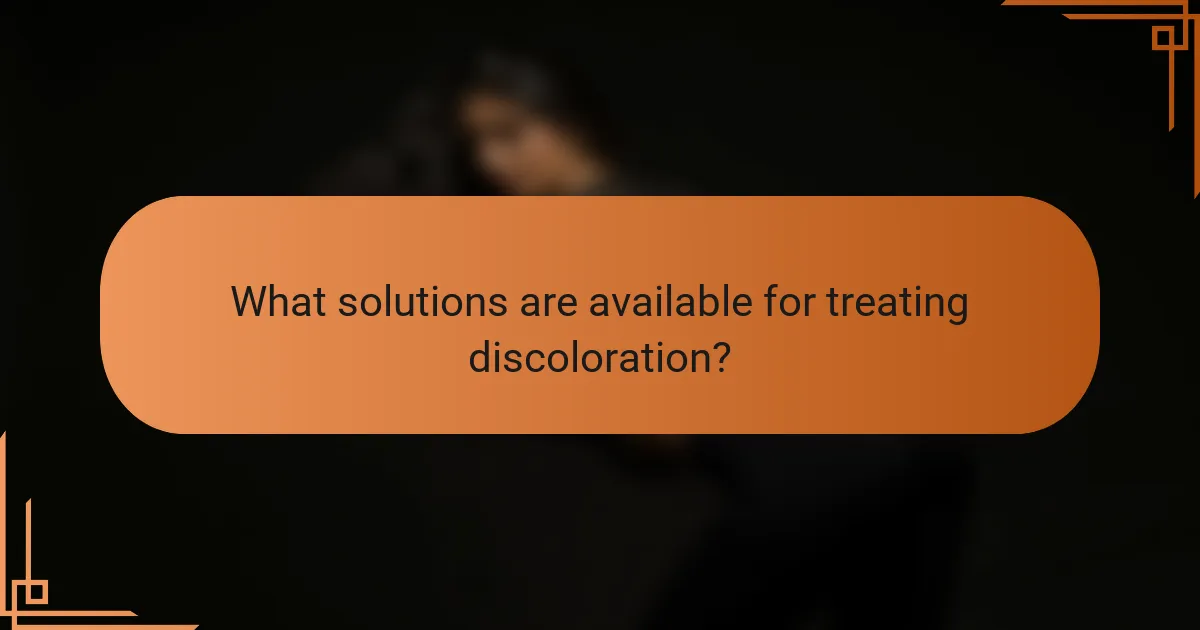
What solutions are available for treating discoloration?
Solutions for treating discoloration include professional cleaning, stain removal treatments, and fabric whitening agents. Professional cleaning uses specialized techniques to restore the dress’s original color. Stain removal treatments target specific discolorations caused by substances like wine or dirt. Fabric whitening agents can help lighten overall discoloration. These methods are effective in restoring the dress’s appearance. Many bridal shops and dry cleaners offer these services. Research indicates that proper care can significantly improve the dress’s condition.
How can you clean a discolored wedding dress effectively?
To clean a discolored wedding dress effectively, start by identifying the type of fabric. Different fabrics require specific cleaning methods. For most fabrics, hand washing is recommended. Use a gentle detergent and cold water to prevent further discoloration. Soak the dress for about 30 minutes, then gently agitate the water. Rinse thoroughly with cold water to remove all detergent. If stains persist, consider using a stain remover suitable for the fabric type. Always test the stain remover on a hidden area first. For delicate fabrics, professional cleaning is advisable. Dry the dress away from direct sunlight to avoid fading.
What cleaning methods are safe for delicate fabrics?
Gentle cleaning methods are safe for delicate fabrics. Hand washing in cold water with mild detergent is effective. Spot cleaning with a soft cloth and specialized fabric cleaner is also recommended. Dry cleaning can be safe if the cleaner is experienced with delicate materials. Steam cleaning is an option for certain fabrics but should be approached with caution. Always test a small area first to avoid damage. These methods help maintain the integrity of delicate fabrics while effectively removing stains.
How do you choose the right cleaning products for discoloration?
To choose the right cleaning products for discoloration, identify the type of fabric in the wedding dress. Different fabrics require specific cleaning agents. For example, silk may need a gentle cleaner, while cotton can handle stronger solutions.
Next, consider the nature of the discoloration. For stains, use a targeted stain remover. For yellowing, opt for a product designed to brighten fabrics. Always check the product label for compatibility with the fabric type.
Perform a patch test on a hidden area to ensure no damage occurs. This step is crucial to prevent further discoloration or fabric degradation.
Research indicates that using pH-neutral cleaners can help maintain fabric integrity while effectively addressing discoloration. Always follow the manufacturer’s care instructions for the best results.
What preventive measures can be taken to avoid discoloration?
To avoid discoloration in pre-owned wedding dresses, store them in a cool, dark place. Exposure to light can cause fading and yellowing. Use acid-free tissue paper to wrap the dress, preventing fabric contact that can lead to discoloration. Maintain a stable humidity level to avoid moisture accumulation, which can cause stains and mildew. Clean the dress with a gentle, pH-neutral detergent before storage to remove any potential staining agents. Regularly inspect the dress for any signs of discoloration or damage. Avoid hanging the dress for long periods, as this can stretch the fabric and lead to uneven discoloration.
How can proper storage help maintain the dress’s color?
Proper storage helps maintain a dress’s color by preventing exposure to light and humidity. Light can fade colors over time, especially direct sunlight. Storing the dress in a dark, cool place minimizes this risk. Humidity can cause mold and mildew, which can discolor fabric. Using breathable garment bags allows air circulation while protecting from moisture. Additionally, keeping the dress away from heat sources prevents fabric damage. These storage practices ensure that the dress retains its original color and vibrancy.
What are the best practices for handling and displaying pre-owned wedding dresses?
The best practices for handling and displaying pre-owned wedding dresses include careful inspection, gentle cleaning, and proper storage. Inspect the dress for any signs of discoloration or damage before handling. Use white cotton gloves to prevent oils from your hands from transferring to the fabric. When cleaning, opt for a professional dry cleaner experienced with delicate fabrics. Avoid harsh chemicals that can cause further discoloration. Store the dress in a breathable garment bag to protect it from dust and light exposure. Display the dress on a padded hanger to maintain its shape. Avoid direct sunlight to prevent fading. Regularly check the dress for any changes in condition. These practices help preserve the integrity and appearance of pre-owned wedding dresses.
What are the best tips for maintaining the beauty of pre-owned wedding dresses?
To maintain the beauty of pre-owned wedding dresses, proper care is essential. First, store the dress in a cool, dry place away from sunlight. This prevents fading and deterioration of fabric. Use a breathable garment bag to protect it from dust and moisture. Avoid plastic covers, as they can trap humidity and lead to mold.
Regularly check the dress for any signs of discoloration or damage. If stains are found, address them promptly using a gentle fabric cleaner. Professional cleaning is recommended for delicate fabrics. Additionally, handle the dress with clean hands to avoid transferring oils or dirt.
For long-term preservation, consider using acid-free tissue paper when storing the dress. This helps maintain its shape and prevents creasing. Lastly, avoid wearing the dress in environments where it may be exposed to strong fragrances or smoke, as these can cause lingering odors.
Discoloration in pre-owned wedding dresses refers to the change in color or appearance of the fabric, often caused by factors such as age, exposure to light, and improper storage. Common types of discoloration include yellowing, browning, and fading, which can significantly impact the dress’s aesthetic and resale value. The article explores the causes of discoloration, the importance of early detection, and effective cleaning methods, along with preventive measures to maintain the dress’s original appearance. It also highlights the specific areas prone to discoloration and provides tips for proper handling and storage to preserve the beauty of wedding dresses over time.
